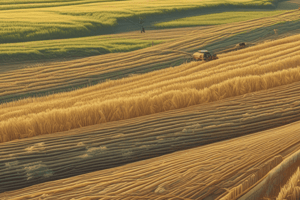Podcast
Questions and Answers
What is the primary purpose of crop rotation in farming?
What is the primary purpose of crop rotation in farming?
- To improve soil fertility
- To control weeds and pests
- To increase crop yields
- To control diseases through indirect means (correct)
What is a major difference between certified and uncertified seed?
What is a major difference between certified and uncertified seed?
- Certified seeds have greater uniformity (correct)
- Certified seeds are more expensive
- Certified seeds have better disease resistance
- Certified seeds have higher germination rates
What is a major hazard associated with crop management?
What is a major hazard associated with crop management?
- Weather-related damage
- Pest infestations
- Soil erosion
- Farm health and safety hazards (correct)
What is a key benefit of biotechnological applications in crop development?
What is a key benefit of biotechnological applications in crop development?
What is a key difference between conventional and organic food production?
What is a key difference between conventional and organic food production?
What is a major advantage of using certified seed in crop production?
What is a major advantage of using certified seed in crop production?
Which of the following is a key principle in controlling diseases in crops?
Which of the following is a key principle in controlling diseases in crops?
What is a major difference between establishment for grass and that of maize?
What is a major difference between establishment for grass and that of maize?
What is a key benefit of biotechnological applications in crop development?
What is a key benefit of biotechnological applications in crop development?
What is a key principle in preventing accidents and injury on the farm?
What is a key principle in preventing accidents and injury on the farm?
Flashcards are hidden until you start studying
Study Notes
Crop Protection Strategies
- Crop diseases can be caused by fungi, bacteria, or viruses, and require specific protection strategies
- Different control methods include chemical, biological, cultural, and integrated pest management (IPM) approaches
- Resistance breeding and genetic engineering are used to develop disease-resistant crop varieties
Plant Uniformity from Certified and Uncertified Seed
- Certified seed guarantees standardized quality, uniformity, and high germination rates
- Uncertified seed may have variable quality, lower germination rates, and increased risk of disease
- Uniformity is crucial for optimal crop growth, yield, and management practices
Crop Establishment
- Establishing grass requires proper soil preparation, adequate moisture, and suitable sowing rates
- In contrast, establishing corn (for example) requires additional considerations such as fertilization, pest control, and irrigation
- Each crop has unique establishment requirements, affecting its growth and productivity
Farm Health and Safety
- Farm health and safety hazards include pesticide exposure, equipment operation, and manual handling
- Controls and precautions to prevent accidents, injury, and ill health include personal protective equipment (PPE), training, and regular maintenance
- A safe working environment is essential for farmers, workers, and visitors
Conventional vs Organic Food Production
- Conventional farming relies on synthetic fertilizers, pesticides, and genetically modified organisms (GMOs)
- Organic farming emphasizes natural methods, crop rotation, and biological pest control
- Both approaches have advantages and disadvantages, influencing crop yields, environmental impact, and consumer choice
Crop Rotation
- Crop rotation is a key strategy for indirect disease control, soil fertility management, and pest management
- Crop rotation benefits include reduced soil erosion, improved soil structure, and increased biodiversity
- Alternatives to crop rotation include monoculture, intercropping, and relay cropping
Innovation and Biotechnology in Crop Development
- Biotechnological applications include genetic modification, marker-assisted selection, and precision agriculture
- Innovation in crop development enables improved yields, disease resistance, and nutrient use efficiency
- Biotechnology can address global food security, environmental sustainability, and climate change challenges
Crop Protection Strategies
- Crop protection involves combating diseases caused by fungi, bacteria, and viruses
- Various strategies are employed to prevent and control disease outbreaks, including cultural, chemical, biological, and integrated pest management (IPM) approaches
- Cultural practices include crop rotation, pruning, sanitation, and modified irrigation systems
- Chemical controls involve the use of fungicides, bactericides, and viricides to eradicate or manage disease-causing agents
- Biological controls utilise natural predators, parasites, or competitors of the disease-causing organisms
- IPM integrates multiple approaches to minimize disease incidence and maintain ecological balance
Certified vs. Uncertified Seed
- Certified seed ensures uniformity and purity of the crop, reducing the risk of disease transmission and poor growth
- Uncertified seed may exhibit variations in growth rates, susceptibility to diseases, and yield quality
- Certified seed is produced under strict quality control measures, including disease testing and inspection
Grass Establishment
- Grass establishment involves preparation of the soil, seeding, and post-seeding care
- Compared to other crops, grass establishment is relatively low-maintenance, requiring less irrigation and fertilization
- Proper soil preparation, including aeration and fertilization, enhances grass establishment and growth
Farm Health and Safety
- Health and safety hazards on the farm include exposure to pesticides, heavy machinery, and ergonomic risks
- Controls and precautions necessary to prevent accidents, injury, and ill health include:
- Personal protective equipment (PPE) usage
- Training on equipment operation and chemical handling
- Implementing ergonomic practices to reduce manual labor strain
- Ensuring proper ventilation and sanitation
Conventional vs. Organic Food Production
- Conventional food production relies on synthetic fertilizers, pesticides, and irrigation systems to maximize yields
- Organic food production emphasizes ecological balance, using natural pest control methods, composting, and crop rotation
- Conventional methods may result in higher yields, but organic production prioritizes environmental sustainability and human health
Crop Rotation
- Crop rotation involves alternating different crops on the same land to reduce disease incidence and improve soil fertility
- Benefits of crop rotation include:
- Breaking disease cycles and reducing pesticide use
- Enhancing soil structure and fertility
- Promoting biodiversity and ecological balance
- Alternatives to crop rotation include:
- Crop monoculture with integrated disease management
- Using disease-resistant crop varieties
- Implementing conservation agriculture practices
Biotechnology in Crop Development and Management
- Biotechnological applications in crop development and management include:
- Genetic engineering for disease resistance and improved yields
- Marker-assisted selection for desirable traits
- Precision agriculture for optimized resource allocation
- Biotechnology enhances crop productivity, sustainability, and disease resistance, contributing to global food security
Studying That Suits You
Use AI to generate personalized quizzes and flashcards to suit your learning preferences.




